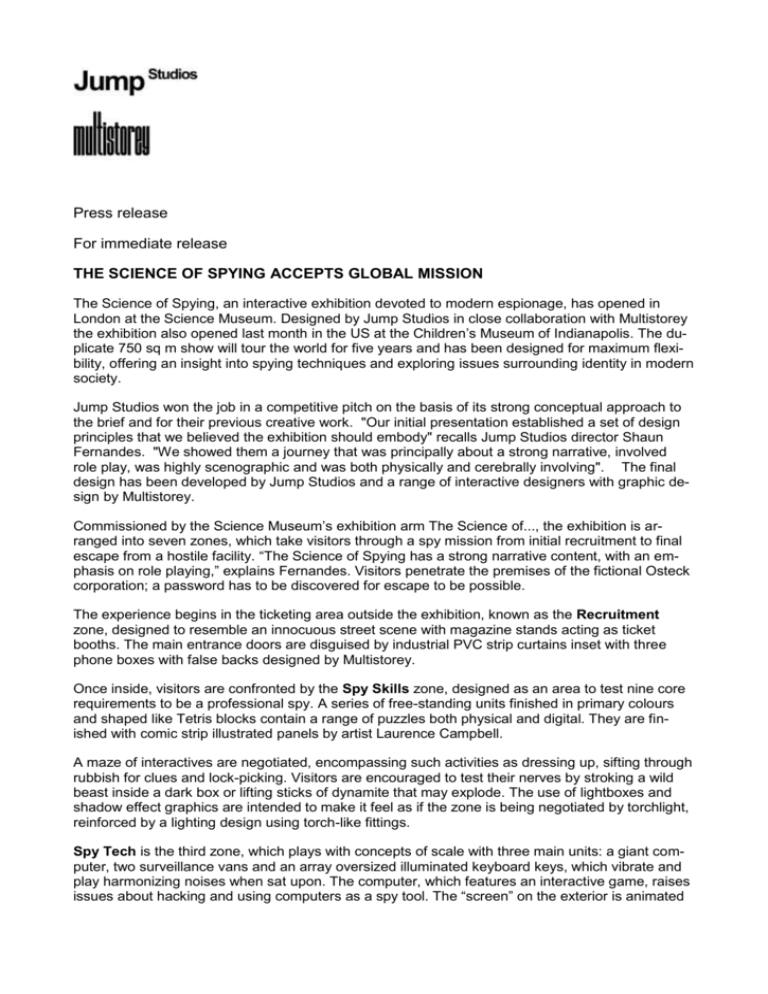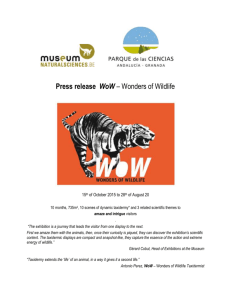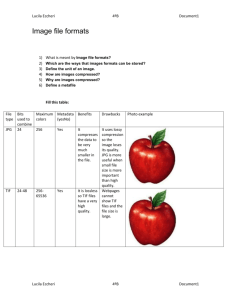press release text
advertisement

Press release For immediate release THE SCIENCE OF SPYING ACCEPTS GLOBAL MISSION The Science of Spying, an interactive exhibition devoted to modern espionage, has opened in London at the Science Museum. Designed by Jump Studios in close collaboration with Multistorey the exhibition also opened last month in the US at the Children’s Museum of Indianapolis. The duplicate 750 sq m show will tour the world for five years and has been designed for maximum flexibility, offering an insight into spying techniques and exploring issues surrounding identity in modern society. Jump Studios won the job in a competitive pitch on the basis of its strong conceptual approach to the brief and for their previous creative work. "Our initial presentation established a set of design principles that we believed the exhibition should embody" recalls Jump Studios director Shaun Fernandes. "We showed them a journey that was principally about a strong narrative, involved role play, was highly scenographic and was both physically and cerebrally involving". The final design has been developed by Jump Studios and a range of interactive designers with graphic design by Multistorey. Commissioned by the Science Museum’s exhibition arm The Science of..., the exhibition is arranged into seven zones, which take visitors through a spy mission from initial recruitment to final escape from a hostile facility. “The Science of Spying has a strong narrative content, with an emphasis on role playing,” explains Fernandes. Visitors penetrate the premises of the fictional Osteck corporation; a password has to be discovered for escape to be possible. The experience begins in the ticketing area outside the exhibition, known as the Recruitment zone, designed to resemble an innocuous street scene with magazine stands acting as ticket booths. The main entrance doors are disguised by industrial PVC strip curtains inset with three phone boxes with false backs designed by Multistorey. Once inside, visitors are confronted by the Spy Skills zone, designed as an area to test nine core requirements to be a professional spy. A series of free-standing units finished in primary colours and shaped like Tetris blocks contain a range of puzzles both physical and digital. They are finished with comic strip illustrated panels by artist Laurence Campbell. A maze of interactives are negotiated, encompassing such activities as dressing up, sifting through rubbish for clues and lock-picking. Visitors are encouraged to test their nerves by stroking a wild beast inside a dark box or lifting sticks of dynamite that may explode. The use of lightboxes and shadow effect graphics are intended to make it feel as if the zone is being negotiated by torchlight, reinforced by a lighting design using torch-like fittings. Spy Tech is the third zone, which plays with concepts of scale with three main units: a giant computer, two surveillance vans and an array oversized illuminated keyboard keys, which vibrate and play harmonizing noises when sat upon. The computer, which features an interactive game, raises issues about hacking and using computers as a spy tool. The “screen” on the exterior is animated by a 2m tall lenticular display with an illustrated five stage zoom-in sequence. One of the vans features an exhibition of objects used for spying such as spyplanes, while the other incorporates three “biometric” face-scanning stations. “The next zone Spy World offers a number of different narrative threads, playing with the concept of watcher and watched,” says Jump’s Fernandes. “Visitors choose to undergo either a body or brain scan, which determines whether they exit into the “front-of-house” Osteck Lobby or behindthe-scenes in the Disused Osteck Storeroom.” In both are several interactives which reveal a secret code which visitors must “steal”. The Lobby is a futuristic space with zigzagging grey walls which play with a sense of perspective. Mirrors in the shape of life-sized office employees add to the sensation of being watched, while a number of abandoned objects including a toolbox make it feel as if the Lobby has been recently deserted. The Storeroom has a more utilitarian aesthetic that also reinforces the idea that Osteck is nothing more than a stage set. Seating is provided by foam cubes resembling packing crates and Pizza box cushion pads. “It’s the debris of a prolonged stakeout,” says Rhonda Drakeford, creative director of Multistorey. Spyholes, hidden cameras and two-way mirrors mean that it’s possible to spy on people in the Lobby. Future Spy is designed like a more traditional exhibition environment, envisaged as a “secret vault” with objects in drawers or behind glass. A number of leading product designers, including El Ultimo Grito and Troika, were asked to come up with ideas for future spying devices. A spectrum of coloured industrial PVC strips clad the laboratory storage cabinets and walls. Visitors “escape” the exhibition through the Osteck Loading Bay, which incorporates an impressive body scanner interactive game which identifies the outline of humans and sounds an alarm. The only way to pass through is to pretend to be non-human. The exterior has been clad to look like a loading bay with metal shutters and industrial signage. Outside is a space where visitors can leave feedback on a façade-like feedback wall designed by Multistorey, before entering the Retail Space designed by Kit Grover, which picks up on the loading bay aesthetic using oil drums to display products. Designing an exhibition that will travel throughout the world has meant ensuring content is not specific to the UK and also making sure each element is as durable as possible. For example, the zigzagging walls in Spy World are demountable, and can be re-erected at any angle, simply with the addition of new joining elements. “Content needed to appeal to a broad range of age groups and engage at different levels of complexity, to maximize it's relevance to all potential visitors" explains Fernandes. Multistorey’s Drakeford adds that graphic elements had to incorporate text that is easily legible to people with learning difficulties, while the font also needed to be suitable for dual language venues with non-English alphabets. “We analysed each and every text block to allow for the worst case scenario of future type setting,” she explains. The Indianapolis exhibition has been customised to fit a smaller space than the Science Museum, while also dealing with a challenging site which includes curved walls and low ceiling heights. /ends Notes to editors The Science of Spying runs at the Science Museum until September 2007. It opened in Indianapolis on 16 March. A full set of high resolution photographs is available upon request. Jump Studios is an award-winning architecture and design studio based in London. Established in 2001, Jump has worked on a wide variety of projects including architecture, interiors, product, graphic and packaging design. Recent projects include Red Bull’s headquarters, retail outlets for Offspring, O2 and Honda, and offices for advertising agency Wieden + Kennedy. Multistorey is a London-based studio specialising in art direction and graphic design. Founded by Rhonda Drakeford and Harry Woodrow in 1997, Multistorey works with a wide range of clients from fledgling fashion houses to multinational corporations. Projects include branding and identity, packaging, book and print design and advertising campaigns. Credits: Architecture and design: Jump Studio (Simon Jordan, Shaun Fernandes, Daniel Dendra, Markus Nonn) Art direction and graphic design: Multistorey (Rhonda Drakeford, Harry Woodrow) Comic illustrations: Laurence Campbell and Dylan Teague Interactives/AV: AllofUs, Centre Screen Productions, Kiss the Frog, Luckybite, Paragon, RolfK, Science Projects, Spiral Productions Modelmaking: Cod Steaks, The Glue Factory Future Spy Product Design: Auger-Loizeau, Dunne and Raby (with Graeme Findlay), El Ultimo Grito, Kok-Chian Leong, Noam Toran (with Nick Williamson), Onkar Singh Kular (with Wilfrid Wood and Anthony Burrill), Troika Curation and research: The Science of... Contractor: Beck Interiors Lighting Design: LAPD Lighting Consultants Retail: Kit Grover M&E services: SVM Consulting Engineers Photographs: Gareth Gardner: 01-gg_MG_4982.jpg 02-gg_MG_2886.jpg 02-gg_MG_2897 square.jpg 02-gg_MG_2897.jpg 03A-gg_MG_2914.jpg 03A-gg_MG_2922.jpg 03A-gg_MG_3025 square.jpg 03A-gg_MG_4834.jpg 04B-gg_MG_4633.jpg 04-gg_MG_2972 cropped.jpg 04-gg_MG_3100 crop 03.tif 04-gg_MG_4651.jpg 04-gg_MG_4665.jpg 05a-gg_MG_4672.jpg 05-gg_MG_4700.jpg Iain Dickens: 01-MS_S8Q7526.tif 02g-MS-Science Museum_009.tif 02g-MS-Science Museum_023.tif 02-MS-02-Science Museum_123.jpg 02-MS-Science Museum_074.tif 02-MS-Science Museum_080.tif 02-MS-Science Museum_097.tif 03A-MS_S8Q7532 cropped.tif 04-MS_S8Q7565 cropped.tif 04-MS_S8Q7565.tif Beck Interiors: 03a-Beck-Stitch3.tif 3B-Beck_I0Q8225Spy Beck Interiors cropped.tif






